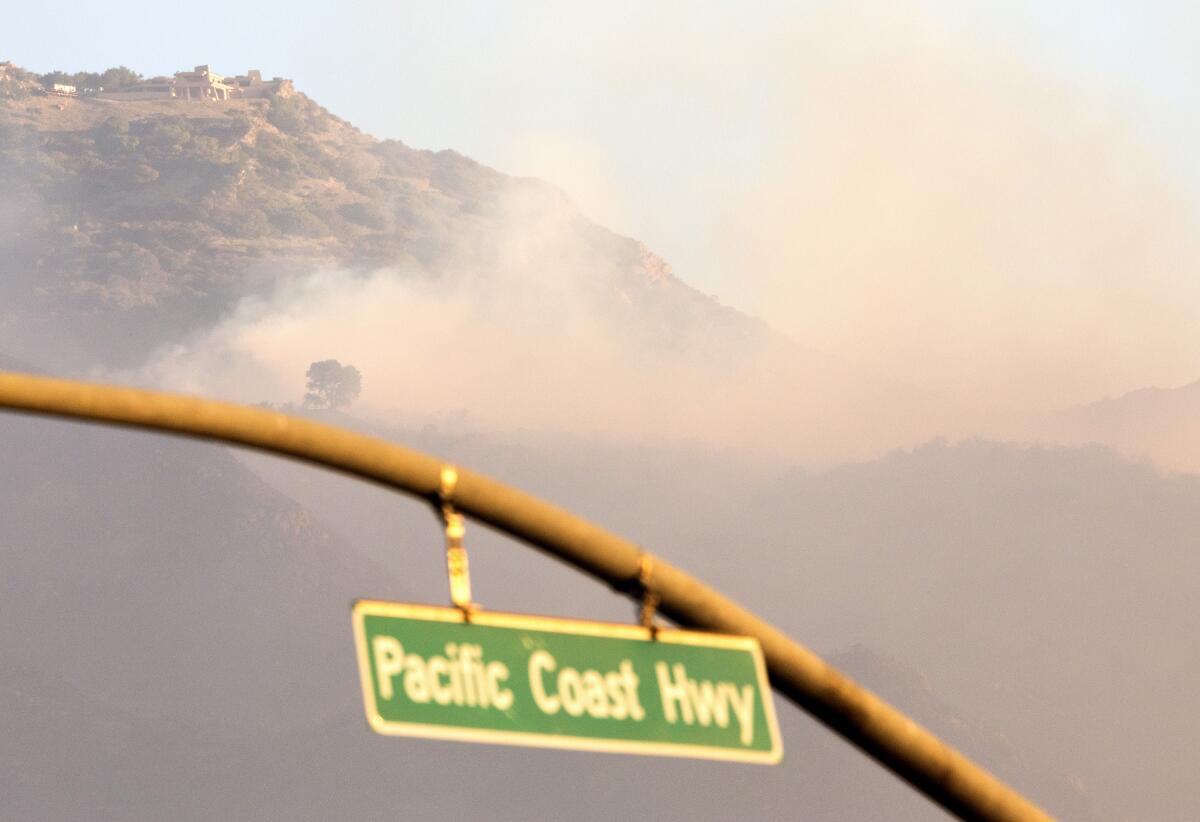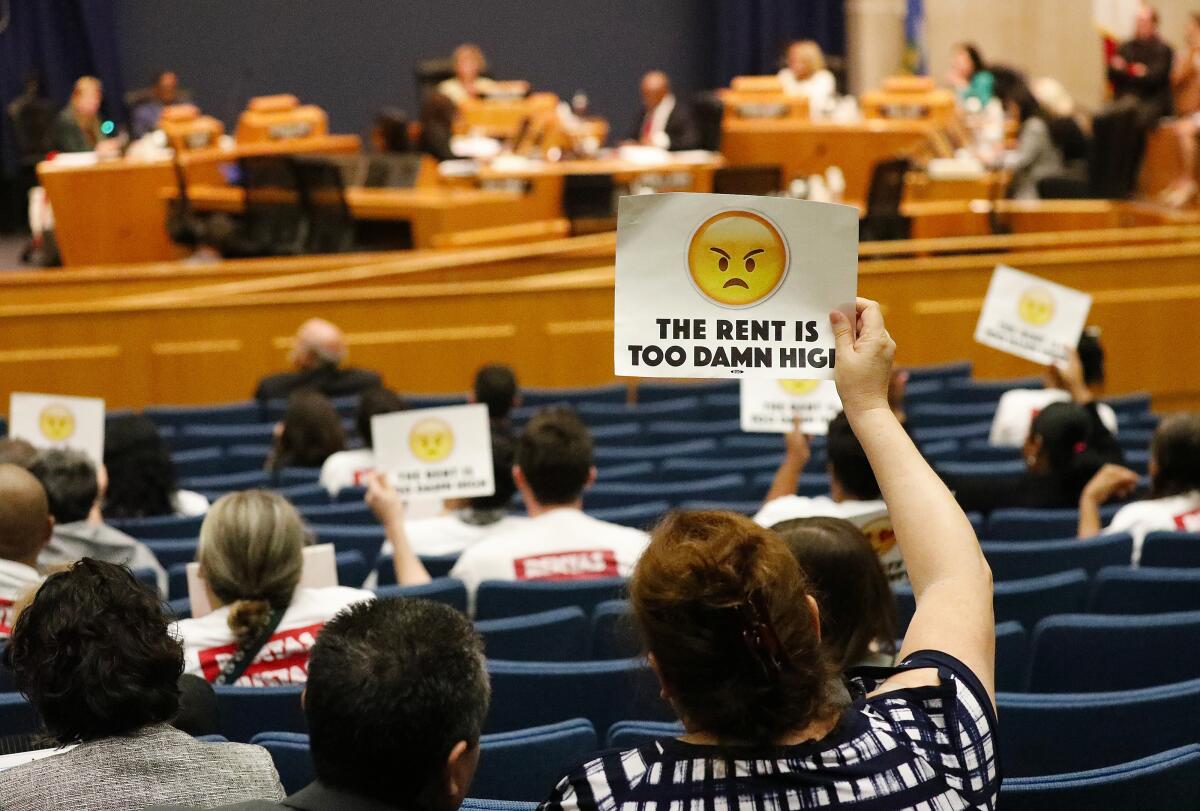A destructive fire began near Pepperdine University. Here’s what to know

- Share via
Good morning. Here’s what you need to know to start your day.
- What to know about the wildfire that broke out near Pepperdine University.
- Landlords beware: Rent-shamers are calling out overpriced listings online.
- Joining a social club is good for your health. Here are 7 quirky ones in L.A. to get you started.
- And here’s today’s e-newspaper.
Sign up for Essential California
The most important California stories and recommendations in your inbox every morning.
You may occasionally receive promotional content from the Los Angeles Times.
What to know about the Franklin fire in Malibu
This week’s red flag warnings brought a threat of wildfires that was realized late Monday when a blaze broke out in Malibu, prompting mass evacuations of nearby homes and forcing students and staff at Pepperdine University to shelter in place.
More than 800 firefighters from Los Angeles County and neighboring agencies were on the scene to try to contain the Franklin fire, which was reported just before 11 p.m. Monday along Malibu Canyon Road in the hills north of Pepperdine.
The blaze engulfed more than 2,000 acres overnight, as crews contended with strong Santa Ana winds.

Here is the latest information from fire officials:
- More than 3,980 acres have burned, according to estimates posted at 6 a.m. Wednesday.
- The fire is 7% contained.
- At least seven homes were destroyed and eight damaged, but officials said that number could rise.
- About 6,000 people remain under mandatory evacuation orders.
- No serious injuries have been reported.
- The cause of the blaze is under investigation.
A 3D map from CalFire showed the burn zone extending into the campus and right up to buildings. Videos posted to social media showed students watching flames burn right outside the buildings they were sheltering in, shrouded in an orange-gray glow of fire and smoke.
“It was so close that we got the warning to stay away from the windows because the trees that were a good 20 feet ahead of it were on fire,” Pepperdine student Nick Gerding told KTLA-TV during a Tuesday morning interview.
Many residents were without power Tuesday because of emergency shutoffs by firefighters and power utilities. Cellphone service was also limited because the fire damaged cell towers, according to L.A. County Sheriff Robert Luna.

Officials from Pepperdine also reported the campus was without power, save for several buildings that were able to run generators.
Times reporters spoke with residents who recounted their harrowing experiences.
One Malibu couple, Jessica Jones and Matthew Ryder, barely had time to grab important documents and clothes as the fire headed toward their ranch home. But they also had to wrangle their three goats and a potbellied pig before making their getaway just as flames reached the property.
“I wish we had grabbed more stuff or been better prepared this time around,” Jones told Times reporter Nathan Solis. “I guess you could say we were a bit complacent.”

The Franklin fire is burning within much of the footprint of 2018’s devastating Woolsey fire, which destroyed more than 1,600 structures and burned about 97,000 acres in Malibu, the Santa Monica Mountains and surrounding communities of Thousand Oaks, Oak Park and Agoura Hills.
Research shows wildfires have grown more intense in recent decades, fueled by wildfire weather (hot, dry conditions plus wind) that’s become more frequent — especially in California.
“Southern California had a couple of wet years in a row, and that means a build-up of fuels in wildlands,” Alex Hall, director of UCLA’s Center for Climate Science, wrote in a statement. “The current wet season has been very dry so far. The sequence of very wet followed dry conditions sets the stage for big wildfires.”
The origin point of the blaze is textbook wildland-urban interface, or WUI (woo-ee). Those are the places where human development spreads into wild, undeveloped spaces.

Historically, wildfires are a regular and natural part of the ecosystem in and around the Santa Monica Mountains. But in modern times, humans nearly always cause wildfires, and the presence of homes and other structures adds to the destructive potential.
Cal Fire estimates that 95% of wildfires are caused by humans, including from carelessness, deliberate ignitions and infrastructure failures.
The Times newsroom continues to cover the Franklin fire. You can read more of our reporting below. You can also check the L.A. County Fire Department’s emergency website for more information.
- Wildfire explodes in Malibu, damaging homes and spurring mass evacuations
- Franklin fire: Evacuations, road closures, shelters in Malibu
- Malibu endures cellphone, power outages as Franklin fire burns
- Winds whip Southland, fuel Malibu fire: Where SoCal Edison has shut off power
- ‘It was insane’: Malibu couple escapes flames with their 3 goats and potbellied pig
- Through a window, Pepperdine students watch the Malibu fire engulf their campus
Today’s top stories

As rents rise, tenants are calling out landlords and real estate agents
- “Rent shaming” has sprouted up across Facebook housing groups and other social media platforms as rent continues to soar across Southern California.
- Landlords see it as cyberbullying. Renters see it as a higher calling — a form of resistance and a way to call out overpriced listings.
Luigi Mangione was reported missing in San Francisco before CEO was killed
- Mangione’s mother filed a missing person report for her son in November in San Francisco, the Associated Press confirmed using two law enforcement sources.
- Posts from a since-deleted Reddit account, with details matching Mangione’s, indicate the Reddit user suffered from a condition in which a vertebra in the spine, usually in the lower back, slips out of place. The Reddit user wrote that his condition got worse after a surfing accident.
Gov. Newsom’s electric vehicle mandate may be hitting a serious speed bump
- Sales of electric vehicles have stalled as Trump plans to eliminate EV tax credits and slap tariffs on imports that could impact the market.
- The headwinds are fueling fresh doubts about Newsom’s mandate that all new cars sold in California by 2035 must be zero-emission vehicles.
Will Kamala Harris run for California governor in 2026? The question is already swirling
- Harris has yet to give any public indication on her thoughts, and those close to her suggest the governorship is not immediately top of mind. But if she does run, she would seismically reshape an already crowded race.
- Recent polling suggests Harris would have a major advantage, with 46% of likely voters saying they were somewhat or very likely to support her for governor in 2026.
What else is going on
- Trump named California Republican Harmeet Dhillon for a top civil rights post.
- After reducing deficit, Newsom proposals bring extra costs to California.
- Kroger’s plans to buy grocery rival Albertsons was halted by a federal judge.
- Authorities are investigating whether a Marin County child stricken with bird flu could have contracted the illness from recalled raw milk.
- Are you at risk of tsunami flooding in California? Check these maps.
Get unlimited access to the Los Angeles Times. Subscribe here.
Commentary and opinions
- California produced the first female speaker and female vice president. So, columnist Mark Z. Barabak asks, why are women losing ground in Congress?
- Here’s why Donald Trump just doubled down on mass deportation of millions of immigrants, columnist Robin Abcarian writes.
- The TikTok court case has staggering implications for free speech in America, writes Erwin Chemerinsky, dean of the UC Berkeley Law School.
This morning’s must reads
At Beverly Hills High, celebrations over Trump’s victory have ignited simmering racial tensions. Pro-Trump students at Beverly Hills High School staged raucous demonstrations in the aftermath of the election that left some Black students and a teacher shaken. The school is pushing back on some of the accounts.
Other must reads
- Trump is threatening to raise tariffs again. Here’s how China plans to fight back.
How can we make this newsletter more useful? Send comments to [email protected].
For your downtime

Going out
- 👋 Joining a social club is good for your health. Here are seven quirky ones in L.A. to get you started.
- 🎄 Here are 11 holiday pop-up bars to visit in Southern California this season.
- 🎤 Two decades after “The Simple Life,” Paris Hilton and Nicole Richie are ready for an encore.
Staying in
- 🎧 Need something to listen to? Here are the 30 best songs and 20 best albums of 2024.
- 📺 Bob Dylan has starred in or inspired numerous movies. Here are five to watch before the arrival of “A Complete Unknown” starring Timothée Chalamet.
- 🧑🍳 Here’s a recipe for brown butter-cinnamon crumb cake.
- ✏️ Get our free daily crossword puzzle, sudoku, word search and arcade games.
A question for you: What are your favorite holiday traditions?
Maria Borbon writes: “I was raised in a real tamales house. My mother, may she rest in peace, made 100 dozen tamales one year. She gave them away as gifts to neighbors and mechanics who worked on her vehicles.
“All of her many brothers and nephews came from Southern California to sit at her dining room table in Tucson to eat them. They were extra special because she cubed the meat rather than shred it. She added broth from the meat and red chili to the masa. Always used Manteca or shortening in later years.”
Email us at [email protected], and your response might be included in the newsletter this week.
And finally ... your great photo of the day

Today’s great photo is from Loretta Johnson of San Mateo: Emigrant Wilderness, where she took a three-day backpacking trip last year.
Loretta writes: “Emigrant Wilderness, the lesser known cousin of Yosemite National Park to the south, boasts granite peaks, high alpine lakes, meadows and abundant flora and fauna.”
Show us your favorite place in California! Send us photos you have taken of spots in California that are special — natural or human-made — and tell us why they’re important to you.
Have a great day, from the Essential California team
Ryan Fonseca, reporter
Defne Karabatur, fellow
Andrew Campa, Sunday reporter
Hunter Clauss, multiplatform editor
Christian Orozco, assistant editor
Stephanie Chavez, deputy metro editor
Karim Doumar, head of newsletters
Check our top stories, topics and the latest articles on latimes.com.
Sign up for Essential California
The most important California stories and recommendations in your inbox every morning.
You may occasionally receive promotional content from the Los Angeles Times.





